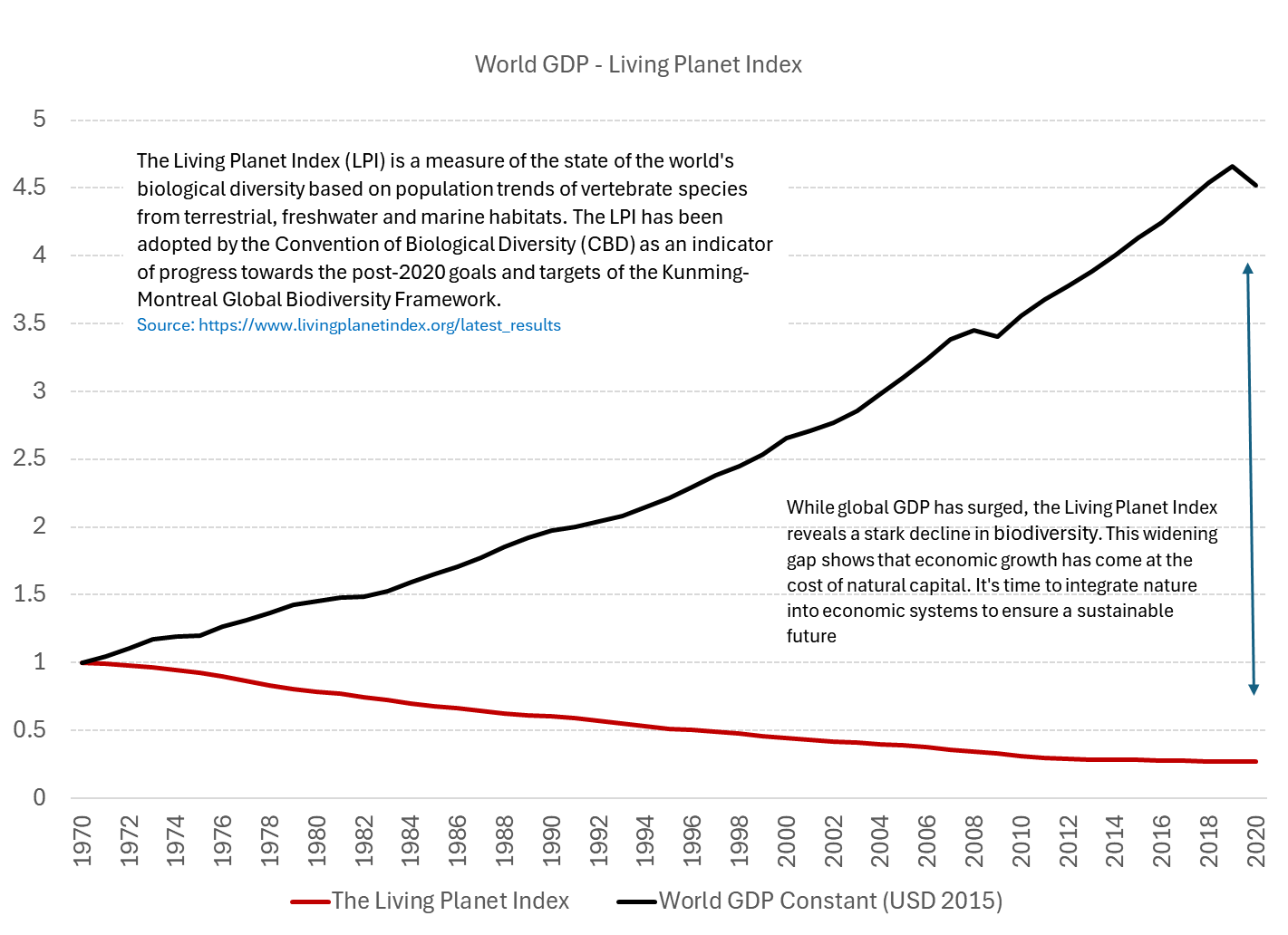Impact as a New Asset Class – Part I

The Impact economy presents a unique opportunity for Investors to achieve strong financial returns while driving positive environmental and social change. By Investing In Nature-Based Solutions and regenerative strategies, Investors can tap into a growing market that restores ecosystems and builds long-term resilience. This approach not only addresses pressing global challenges but also positions capital to lead in the next wave of sustainable development.
The Urgency of Change: Breaching Planetary Boundaries
We are currently at a pivotal moment in history, witnessing the breaching of multiple planetary boundaries, such as climate change, biodiversity loss, and resource depletion. This confluence of environmental crises has pushed our global ecosystem to a tipping point, where swift and decisive intervention is essential to avert irreversible damage. Sustainability is no longer a matter of choice or preference—it is a survival imperative.
As the climate crisis intensifies, businesses, investors, and governments are increasingly turning to innovative solutions that are not only environmentally viable but also economically beneficial. These solutions are reshaping markets, creating a landscape where impact investing plays a key role in generating both financial and ecological resilience. The global demand for strategies that restore planetary health is rising exponentially, positioning natural capital investments as a strategic necessity.

The Regulatory Landscape: Enforcing Transparency and Responsibility
The regulatory landscape is rapidly evolving with frameworks like the EU’s Corporate Sustainability Reporting Directive (CSRD) and the Task Force on Climate-related Financial Disclosures (TCFD) driving organizations to disclose their environmental, social, and governance (ESG) impacts. These regulations aim to promote accountability, reduce negative impacts, and guide efforts toward net-zero emissions between 2030 and 2050. Beyond minimizing harm, companies are now encouraged to generate positive impacts.
The Sustainable Finance Disclosure Regulation (SFDR) complements these efforts by focusing on the financial sector, requiring investors to disclose how they integrate sustainability risks into their investment decisions, thus ensuring that capital flows toward truly sustainable projects. Both the CSRD and SFDR converge on the principle of double materiality, which emphasizes that businesses must report not only how sustainability risks affect their financial performance but also how their activities impact the environment and society.
Emerging guidelines, such as the Taskforce on Nature-related Financial Disclosures (TNFD), stress the importance of recognizing and reporting on nature-related risks and opportunities. As transparency becomes increasingly critical, businesses must integrate sustainable practices into their core strategies, aligning financial goals with ecological and social objectives.
In addition to corporate and financial regulations, global frameworks like the Kunming-Montreal Global Biodiversity Framework (GBF) and Europe’s Nature Restoration Law are setting ambitious targets for nature-positive outcomes. These frameworks emphasize the need for businesses, governments, and financial institutions to integrate biodiversity and ecosystem preservation into their core strategies, driving action on a global scale.
This convergence of corporate and financial regulations, rooted in the principle of double materiality, ensures that both companies and investors are accountable for their environmental and social impacts. Compliance with these evolving regulations will be key to fostering innovation, resilience, and long-term success.
Limitations of Reduction Strategies: The Need for Positive Impact Investments
While reduction strategies—such as decarbonization of value chains and minimizing harmful outputs—remain crucial, they are no longer sufficient to address the scale of today’s environmental challenges. The depletion of natural capital has reached a critical point, and even the most efficient operations continue to place significant stress on ecosystems. This signals the urgent need for a transformative approach that not only reduces harm but actively restores and enhances the planet’s natural systems.
Positive impact investments present this transformative path by going beyond traditional reduction strategies. These investments focus on sectors such as regenerative agriculture, renewable energy, and biodiversity conservation, offering the potential not only to just minimize environmental damage but to regenerate ecosystems and create new sources of sustainable value. By investing in the restoration of natural capital, these approaches address the root causes of environmental degradation rather than simply mitigating its effects.
In addition to restoring ecological balance, positive impact investments unlock new financial opportunities through the enhancement of ecosystem services—such as carbon sequestration, water purification, and soil regeneration. These services not only provide tangible economic returns but also contribute to long-term ecological stability. In essence, positive impact investments create a dual benefit, enhancing the resilience of both natural systems and financial portfolios, ensuring that economies are better equipped to withstand the growing risks associated with climate change and biodiversity loss.
As economies worldwide increasingly prioritize sustainability, positive impact investments will play a central role in creating value within sectors that not only succeed financially but also contribute to the restoration of natural capital. The concept of recognizing nature as an asset class further amplifies the importance of these investments. For investors, aligning capital with these regenerative strategies will be crucial to capturing opportunities in the coming decades, as the future of finance converges with ecological sustainability.
In short, while reduction strategies may help buy time, but investing in the positive regeneration of nature is the only viable long-term strategy to ensure both economic prosperity and ecological resilience.
Nature as an Asset Class: Tapping into a Mispriced Opportunity
As demand for positive impact investments grows, nature is emerging as one of the most under appreciated yet invaluable sources of sustainable value. Historically, we have treated natural capital as a limitless resource, leading to its depletion without accounting for the ecological and financial risks of such extraction. Now, as we reach a tipping point, natural capital is finally being recognized for what it truly is: a critical asset that underpins the global economy.
Nature-based solutions (NbS)—such as reforestation, coastal restoration, and regenerative agriculture—offer dual benefits: they regenerate ecosystems while delivering financial returns through the ecosystem services they restore, such as carbon sequestration, water purification, and biodiversity enhancement. These solutions more than just environmentally beneficial they are infrastructure investments critical to the resilience of entire economies.
However, traditional financial models have largely overlooked the economic potential of natural capital. As a result, natural assets remain significantly undervalued, with the “bank of nature” nearly depleted due to decades of unchecked depletion. This mispricing presents a unique opportunity for investors to access high returns while addressing some of the planet’s most urgent ecological challenges.
By adopting natural capital accounts—a system that assigns measurable economic value to ecosystems and their services—we can accurately track and monitor the biophysical stocks of biodiversity, carbon, and water. This technological advancement enables for the creation of nature-based securities, turning ecological assets into investable financial instruments. These new forms of capital can unlock significant resources for restoring nature, while also generating value for investors.
Recognizing nature as an asset class isn’t just about identifying a new source of returns; it’s about shifting the philosophical view of nature from being a cost to being an integral component of wealth. This transition represents a “reconstruction moment,” akin to the post-war economic rebuilding era, where reinvesting in natural capital is essential for long-term societal and economic sustainability. With the right frameworks in place, such as double materiality and nature-related financial disclosures, this convergence of ecology and finance will allow investors to capture the real value of natural capital while driving sustainable progress for generations to come.
Investing in Natural Capital: One of the Most Attractive Asset Classes of the Future
As reduction strategies reach their limits and regulatory and disclosure frameworks such as the CSRD, SFDR, and TNFD become more stringent, nature-based solutions (NbS) are emerging as one of the most attractive and essential asset classes of the future. These solutions not only provide substantial financial returns but also deliver long-term ecological and societal benefits, making them a powerful vehicle for portfolio diversification and enhancing resilience.
Investing in natural capital through initiatives like reforestation, sustainable agriculture, and habitat conservation offers a natural hedge against climate-related risks. These investments protect portfolios from environmental shocks—such as extreme weather events, biodiversity loss, and soil degradation—while also aligning with evolving regulatory demands and growing consumer expectations in an increasingly sustainability-conscious world.

What makes natural capital investments even more compelling is their ability to catalyze systemic change by supporting the regenerative economy. Unlike traditional investments, which often focus on minimizing harm, natural capital investments restore and enhance ecosystems, helping to replenish the very resources on which human prosperity depends. This shift from depletion to regeneration represents a fundamental transformation in how we create value, positioning nature-based solutions as pivotal to future economic well-being.
Moreover, the financial landscape is evolving with the development of natural capital accounts and nature-based securities, which enable the quantification and monetization of ecosystem services like carbon sequestration, water filtration, and biodiversity preservation. These innovations allow investors to more easily track and manage the performance of natural capital assets, thus unlocking new revenue streams tied to ecological restoration.
As the world pivots toward a regenerative future, those who embrace natural capital investments will lead the way creating positive ecological change but also achieving high returns and unlocking new revenue opportunities. By embedding nature into financial systems—through the recognition of nature as an asset class—investors are in a unique position to drive both economic resilience and planetary health, making these investments an essential component of the portfolios of the future.
